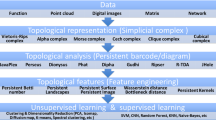Abstract
This article presents a discriminative approach to the protein classification in the particular case of remote homology. The protein family is modelled by a set M of motifs related to the physicochemical properties of the residues. We propose an algorithm for discovering motifs based on the ascending hierarchical classification paradigm. The set M defines a feature space of the sequences: each sequence is transformed into a vector that indicates the possible presence of the motifs belonging to M. We then use the SVM learning method to discriminate the target family. Our hierarchical motif set specifically modelises interleukins among all the structural families of the SCOP database. Our method yields a significantly better remote protein classification compared to spectrum kernel techniques.
Access this chapter
Tax calculation will be finalised at checkout
Purchases are for personal use only
Preview
Unable to display preview. Download preview PDF.
Similar content being viewed by others
References
Vapnik, V.N.: The nature of statistical learning theory. Springer, Heidelberg (1995)
Vapnik, V.N.: Statistical Learning Theory. Springer, Heidelberg (1998)
Scholköpf, B., Guyon, I., Weston, J.: Statistical learning and kernel methods in bioinformatics. In: Frasconi, P., Shamir, R. (eds.) Artificial Intelligence and Heuristic Methods in Bioinformatics, pp. 1–21. IOS Press, Amsterdam (2003)
Jaakola, T., Diekhans, M., Haussler, D.: A discriminative framework for detecting remote protein homologies. Journal of Computationnal Biology 7(1-2), 95–114 (2000)
Li, L., Noble, W.S.: Combining pairwise sequence similarity and support vector machines for detecting remote protein evolutionnary and structural relationships. Journal of Computationnal Biology 10(6), 857–868 (2003)
Leslie, C., Eskin, E., Noble, W.S.: The spectrum kernel: a string kernel for SVM protein classification. In: Proceedings of the Pacific Biocomputing Symposium, pp. 564–575 (2002)
Leslie, C., Eskin, E., Zhou, D., Noble, W.S.: Mismatch String Kernel for SVM protein classification. Bioinformatics 20(4), 467–476 (2004)
Murzin, A.G., Brenner, S.E., Hubbard, T., Chothia, C.: SCOP: a structural classification of proteins database for the investigation of sequences and structures. Journal of Molecular Biology 247, 536–540, 581–586 (1995) ISBN 3-540-41066-X
Author information
Authors and Affiliations
Editor information
Editors and Affiliations
Rights and permissions
Copyright information
© 2004 Springer-Verlag Berlin Heidelberg
About this paper
Cite this paper
Mikolajczack, J., Ramstein, G., Jacques, Y. (2004). SVM-Based Classification of Distant Proteins Using Hierarchical Motifs. In: Yang, Z.R., Yin, H., Everson, R.M. (eds) Intelligent Data Engineering and Automated Learning – IDEAL 2004. IDEAL 2004. Lecture Notes in Computer Science, vol 3177. Springer, Berlin, Heidelberg. https://doi.org/10.1007/978-3-540-28651-6_4
Download citation
DOI: https://doi.org/10.1007/978-3-540-28651-6_4
Publisher Name: Springer, Berlin, Heidelberg
Print ISBN: 978-3-540-22881-3
Online ISBN: 978-3-540-28651-6
eBook Packages: Springer Book Archive




